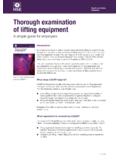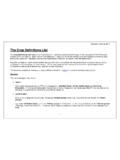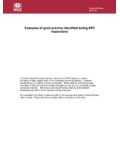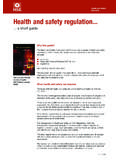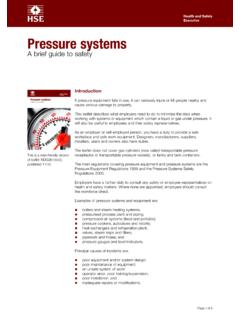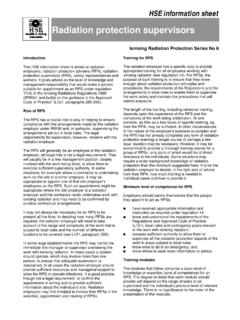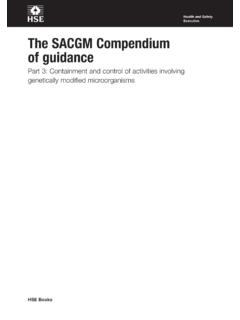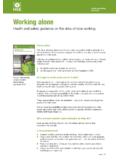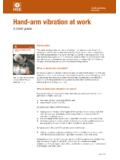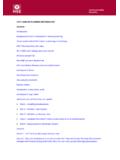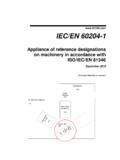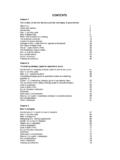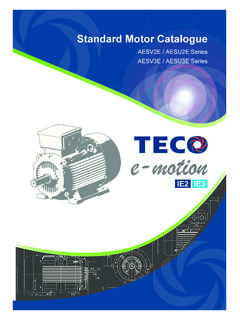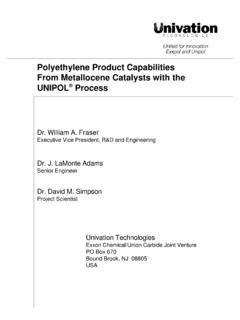Transcription of RR962 - Survey of noise emission and risk information ...
1 Health and Safety Executive Survey of noise emission and risk information supplied with a range of work machinery Prepared by the Health and Safety Laboratory for the Health and Safety Executive 2013. RR962 . Research Report Health and Safety Executive Survey of noise emission and risk information supplied with a range of work machinery Jacqueline Patel BSc (Hons) MSc (Eng) MPhil MIOA. Harpur Hill Buxton Derbyshire SK17 9JN. Previous work has shown that the noise emission data provided by the manufacturers can be of variable quality and be based on standards that no longer exist. In some cases no noise emission data are provided at all.
2 The Health and Safety Executive (HSE) needs to be in a position to challenge or support the validity of noise emission data or other information provided by manufacturers, to offer robust advice to dutyholders on the management of noise exposure based on this information , and facilitate the promotion of low noise machinery on a general or machine specific basis. The aim of the project was to assess the suitability of information on noise emission required under the Supply of machinery (Safety) Regulations and the noise emission in the Environment by Equipment for Use Outdoors Regulations for workplace risk assessment.
3 The noise information provided by manufacturers and suppliers of a wide range of machine types for which noise declaration is required was assessed. This report and the work it describes were funded by the Health and Safety Executive (HSE). Its contents, including any opinions and/or conclusions expressed, are those of the author alone and do not necessarily reflect HSE policy. HSE Books Crown copyright 2013. First published 2013. You may reuse this information (not including logos) free of charge in any format or medium, under the terms of the Open Government Licence. To view the licence visit , write to the information Policy Team, The National Archives, Kew, London TW9 4DU, or email Some images and illustrations may not be owned by the Crown so cannot be reproduced without permission of the copyright owner.
4 Enquiries should be sent to ii KEY MESSAGES. The Health and Safety Laboratory (HSL) assessed a sample of seventy-three sets of instructions across fourteen different machine types against the requirements of the Supply of machinery (Safety) Regulations. The majority of instructions (82% of the sample) contained inadequate noise emission information . As a consequence, it is considered highly likely that purchasers and users of machinery will be unable to make informed choices regarding the safety of potential purchases or understand what control measures are necessary to mitigate the risks from noise during real use.
5 The most common reasons instructions failed to comply with the requirements of the Supply of machinery (Safety) Regulations were absent or incomplete declared noise emission values, absent or incomplete traceability to operating conditions for declared noise emission values, and inadequate information on safe use, residual risk, or noise control measures. Manufacturers and suppliers should be influenced to supply the required noise emission information , either through guidance or enforcement activities. Guidance is also needed on the responsibilities of manufacturers of partly completed machinery and bespoke machinery .
6 Iii iv EXECUTIVE SUMMARY. Objectives Previous work has shown that the noise emission data provided by the manufacturers can be of variable quality and be based on standards that no longer exist. In some cases no noise emission data are provided at all. The Health and Safety Executive (HSE) needs to be in a position to challenge or support the validity of noise emission data or other information provided by manufacturers, to offer robust advice to dutyholders on the management of noise exposure based on this information , and facilitate the promotion of low noise machinery on a general or machine specific basis.
7 The aim of the project was to assess the suitability of information on noise emission required under the Supply of machinery (Safety) Regulations and the noise emission in the Environment by Equipment for Use Outdoors Regulations for workplace risk assessment. The noise information provided by manufacturers and suppliers of a wide range of machine types for which noise declaration is required was assessed. Main Findings Following a review of over three hundred safety standards for machine types where noise was considered a significant hazard, HSE and Health and Safety Laboratory (HSL) noise specialists selected twenty machine types for further investigation based on: the equipment is likely to be a major contributor to significant noise exposure in the workplace, there is potential for reducing noise emission , for example by better design, and further investigation could make a positive contribution to reducing noise exposure in the workplace.
8 The noise emission information contained in the machinery instructions was analysed using the method developed for a European project, referred to as NOMAD, set up by the Administrative Cooperation Group for market surveillance under the machinery Directive ( machinery ADCO). This method enabled both the quality of the noise emission data and its compliance with the requirements of the machinery Safety Regulations to be assessed. Seventy-three sets of instructions were obtained from the manufacturers and suppliers of fourteen different categories of tools and machines. The noise emission information contained in sixty sets of instructions (82% of the sample) failed to satisfy the requirements of the Supply of machinery (Safety) Regulations for the following reasons: Absent or incomplete declared noise emission values.
9 Absent or incomplete traceability to operating conditions for declared noise emission values. Lack of adequate (or in some cases any) information on safe use, residual risks , or noise control measures. The information contained in thirteen sets of instructions satisfied the requirements of the Supply of machinery (Safety) Regulations; six were judged as including comprehensive and high quality noise data and information . Most of the compliant instructions were for tools and machines in the following categories: compaction machines, powered lawnmowers, and edge banding machines. It is considered highly likely that purchasers and users of machinery , who are supplied with inadequate (or missing) noise emission information , will be unable to make informed choices regarding the safety of potential purchases or understand what control measures are necessary to mitigate the risks from noise during real use.
10 V Recommendations Manufacturers and suppliers should be influenced to supply users with the required noise emission information , either through guidance or enforcement activities. Guidance is also needed on the responsibilities of manufacturers of partly completed machinery and bespoke machinery . Several machine categories were identified during this study where further investigation of the noise emission and real use noise exposure should be considered. These include granulators, shredders, masonry and stone cutting machines, floor cutting-off machines, and balers/compactors. These machine types were chosen because: They generate very high noise levels.
